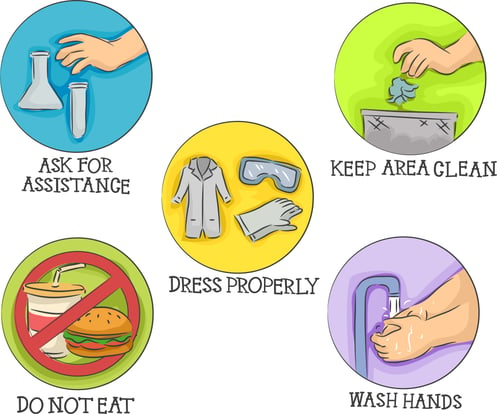
Problem Based Learning Math Guide: Steps and Examples
Students thrive when learning is active, engaging, and meaningful. Problem-based learning transforms math from abstract...
ALI Staff | Published November 23, 2022 | Updated November 03, 2025
It can be hard to watch students struggle in the classroom. But that struggle is critical for students’ development. And it plays an important role in STEM learning.
In education, we call this progression through learning obstacles and challenges productive struggle.
When students face challenges with the right support, they build confidence, persistence, and problem-solving skills. Productive struggle gives those moments direction and meaning.
But what is productive struggle, and why is it important? And how can productive struggle build lasting understanding of STEM concepts while strengthening student-teacher relationships?
Let’s unpack it all here.

Productive struggle in the classroom happens when students work through a challenge that is hard but still possible with support.
It’s not about letting students feel stuck or defeated. Instead, it is about giving them problems that make them think, test ideas, and keep trying until they find a solution. In math, students might look for more than one way to solve a problem. In science, while conducting an experiment, learners might have to adjust if their first test fails.
These experiences feel tough in the moment, but they lead to stronger learning.
Educators often call this the zone of proximal development. It describes the “just right” level of challenge—tasks that are a little beyond what students can do on their own, but achievable with guidance.
Working in this zone helps students remember ideas for longer and apply them in new situations. Brain studies show that when students push through hard tasks, their brains create stronger pathways. This makes knowledge easier to recall later.
In STEM, where problem-solving is at the center, productive struggle gives learners the chance to think like real scientists and engineers. They learn that progress often comes after mistakes, and that effort is part of success.
Productive struggle matters because it helps students build lasting skills and confidence.
When learners work through challenges instead of being given quick answers, they understand more deeply. So rather than merely memorizing steps, they learn how and why concepts work.
Struggle also encourages higher-level thinking.
Students must reason, analyze, and test solutions. These are the same problem-solving skills used by scientists, engineers, and mathematicians in the real world.
For many learners, struggle can change how they see themselves in math and science. When teachers frame challenges as normal and expected, students who once thought “I’m not a math person” begin to see that they are capable.
Research in education and psychology shows that these kinds of challenges are essential for long-term mastery. Tasks that feel too easy do not push the brain to grow.
When students work in their zone of proximal development, it strengthens memory and builds flexible thinking skills. This carries forward into future learning.

Productive struggle is valuable because it does more than help students in the moment — it builds knowledge that lasts. When learners push through challenges with support, they create strong connections they can return to later.
One way this happens is through retrieval practice.
When students recall information without being given the answer, they strengthen their memory. Each attempt to explain or apply an idea makes it easier to remember the next time.
Another way is by encouraging more than one path to a solution. In STEM, problems rarely have a single right answer.
When students compare different approaches or test multiple designs, they deepen their understanding and learn to think flexibly.
Research supports these practices as well. Neuroscientists discovered that when students wrestle with difficult tasks, their brains strengthen neural pathways. This makes recalling information quicker and more reliable over time.
Educators often call this working in the zone of proximal development — the space where tasks are challenging but still achievable with guidance.
Here’s how teachers might see this play out in their classrooms: In a unit on forces and motion, students might be asked to explain why a moving object slows down after being pushed. Instead of giving the answer, the teacher could pose guiding questions and encourage groups to test their ideas with simple materials.
Some might think the reason is weight, others might think it is speed. Over several days of trying and discussing, students could begin to connect their results to friction.
A few weeks later, when the class started a new lesson on energy transfer, friction appeared again.
This time, students were able to recall what they had figured out earlier and explain it clearly.
The concept lasted because they had returned to prior knowledge, tested multiple solutions, and persisted across several days until they understood it.
Productive struggle helps students see that effort leads to growth. When challenges are just beyond their current skills, learners build grit and resilience by sticking with a problem until they find a way forward.
These experiences strengthen a growth mindset, showing students that mistakes and setbacks are part of learning.
A multi-day STEM project makes this clear. Imagine students designing a prototype for a bridge made of simple materials.
On the first day, their design may collapse under the weight. Instead of stopping there, they refine the structure, test again, and keep adjusting. By the end, the bridge is stronger — and so is their persistence.
Teachers guide this process by setting the right level of challenge, stepping in with hints or questions at the right time, and giving feedback that encourages students to try again. This balance keeps the struggle productive, not frustrating.
The skills students practice here go beyond STEM. When they learn how to stay engaged through setbacks, they carry that persistence into reading, writing, and even personal goals outside of school.

Productive struggle not only helps students learn, but it also strengthens trust between students and teachers.
By guiding learners through difficult tasks, teachers show that they believe in their students’ ability to succeed. This kind of support builds confidence and respect on both sides.
The key is knowing when to step in. Sometimes a guiding question or a small hint is enough to move a student forward. Other times, the best choice is to let them keep working on their own. Striking this balance helps students feel both supported and capable.
Here’s how it might look in practice: A student is stuck during a science investigation and can’t get their data to match their prediction. Instead of giving the answer, the teacher asks, “What if you changed one variable and tested it again?” The student makes an adjustment, collects new data, and discovers the solution.
The success feels personal because they arrived at it themselves, and they did so with just enough guidance to keep the struggle productive.
One of the most rewarding parts of productive struggle is the moment when everything finally clicks.
These “aha!” moments often come only after students have worked through real difficulty. Because they find the answer themselves, the learning is more memorable and meaningful.
Take a math class where students look for patterns before discovering a formula. Or a science group that runs an experiment several times before it works.
The moment of success feels bigger because it grew out of persistence and problem-solving.
These breakthroughs build confidence as well as understanding.
When students see that their effort led to success, they are more willing to take on the next challenge. Educators sometimes describe these experiences as a form of desirable difficulty — challenges that feel tough in the moment but lead to stronger, longer-lasting learning.

Productive struggle is especially powerful when students tackle hands-on tasks. These activities invite learners to test ideas, make mistakes, and try again until they discover a solution that works. The trial-and-error process strengthens understanding while encouraging creative thinking.
Here are a few productive struggle examples teachers can use right away:
Each of these productive struggle activities gives students the chance to solve problems in more than one way and reflect on what worked.
Productive struggle often shows up during classroom projects. Imagine a class working in teams to build a bridge from paper, tape, and string.
The first design collapses under weight. After testing and discussion, students adjust the supports, try again, and get closer to success.
With each attempt, they learn from mistakes, improve their design, and eventually create a bridge that holds steady. The pride comes not just from the finished bridge, but from the persistence it took to get there.
Teachers can bring this kind of learning into their own classrooms with a few simple strategies:
Start with guided support. Then gradually release responsibility so students gain independence over time.
Ask students to recall what they already know and apply it to new problems rather than giving answers.
Let students share ideas and learn from different approaches.
Praise effort, persistence, and creative strategies as much as correct answers. Integrate hands-on activities. Use projects with multiple possible outcomes, like design challenges that invite trial and error.
Recognize specific strategies — such as trying a new approach or revising a failed design. That way, students link success to effort and growth, not luck or talent.
These practices make productive struggle part of everyday learning.
Using these steps, you can not only strengthen STEM skills but also build confidence, adaptability, and resilience.

When students see that struggle is part of learning, they face challenges with more confidence.
With the right support and feedback, difficulty can turn into lasting understanding.
Students also gain problem-solving skills they can use far beyond STEM.
For more ready-to-use activities and examples, explore the resources available through STEMscopes.


Students thrive when learning is active, engaging, and meaningful. Problem-based learning transforms math from abstract...

Lab risk assessments are an important part of the STEM classroom. It’s a way to recognize existing and potential...

As a lab teacher, you never have to question the importance of following laboratory safety guidelines. You are well...